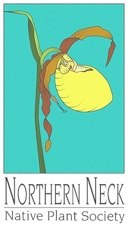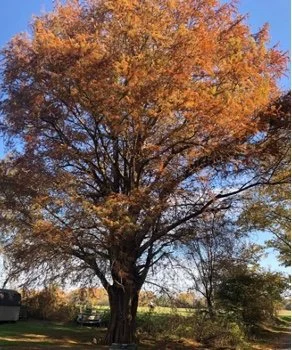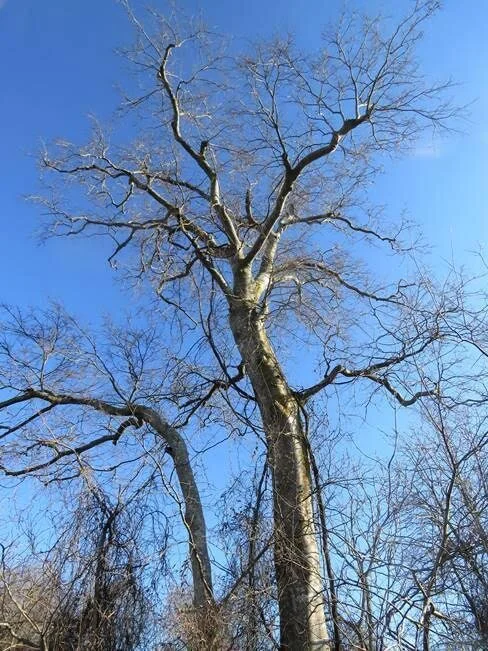Our deciduous woods are graced by many native ferns, but in winter the evergreen Christmas Fern, Polystichum acrostichoides, takes center stage. It literally lights up the woods with its rich green, lustrous foliage that catches the low-angled winter sun, adding sparkle and color. Christmas Ferns are one of the most common ferns in the Southeast and occur in every county in Virginia.
Read MoreThe December Plant of the Month, American Mistletoe, goes by several common names - American, Eastern, Oak, False, or Hairy Mistletoe. This evergreen shrub grows high in the branches of deciduous trees where it is most visible in winter after the leaves fall. While not a plant you would “plant” in your garden, it has a fascinating history centered around the holidays and winter solstice.
Read MoreBaldcypress, Taxodium distichum, our November Plant of the Month, is an unforgettable sight all year but in late fall when its soft foliage turns vibrant shades of copper-orange, it lights up the entire landscape.
Read MoreIn honor of the Halloween season, the October Plant of the Month is Ghost Plant or Indian Pipe – a very unusual member of the Heath family which includes blueberries, rhododendrons, and azaleas. This small perennial is often mistaken for a fungus with its ghostly white, green waxy, translucent stems and flowers. It completely lacks chlorophyll which gives plants their green color, so cannot photosynthesize or obtain energy from the sun. Instead, it obtains its nutrients by parasitizing the fungi that have symbiotic relationships with trees such as oaks and pines.
Read MoreMistflower, Blue Mist Flower or Hardy Ageratum, Conoclinium coelestinum, is aptly named for the soft clouds of fuzzy, lavender-blue flowers that top the plant in late summer and fall. Mistflower is a mounded and often densely branched, spreading perennial. Formerly classified in the genus Eupatorium, along with its larger cousins, the Joe-pye-weeds and Bonesets, Mistflower is much smaller, reaching only 1.5 - 3’ tall and wide. It also differs from its taller cousins in having opposite leaves that are rhomboid or triangular in shape with blunt teeth along the margins instead of having leaves in a whorl around the stem, and for the soft blue flowers unlike the soft mauve flowerheads of the Joe-pye-weeds and the white flowers of the bonesets. The lovely soft blue flowers cover the plant from late July well into fall, blooming for two months or more. The flowers consist entirely of tubular “disk” florets without the showy ray flowers of many daisies and asters. These small lavender-blue tubular florets are held in flat clusters about 1 – 3” across, with 40 – 50 disk florets in each flowerhead. The style (female reproductive part) extends beyond the corolla and is divided into 2 threadlike parts giving the flowerheads a distinctive misty or fuzzy look. In fact the soft blue flowers look much like the annual garden ageratum, and it is sometimes called hardy or wild ageratum.
Read MoreJoe-pye-weeds, Eutrochium, are among our most dramatic late summer perennials lighting up both fields and gardens. They have distinctive leaves arranged in whorls at intervals along sturdy stems, topped with large rosy- purple to soft mauve pink flowerheads. These late season beauties begin to bloom in late July and often continue blooming well into September and are superlative pollinator plants, attracting clouds of butterflies, bees, and more.
Hollow Joe-pye-weed, Eutrochium fistulosum, is one of the most dramatic, with tall statuesque stems that can soar to 8 or 9’ in height (more typically 5 – 7’) creating a stunning spectacle.
Read MoreAll of the species of Mountain-mints are virtual pollinator and butterfly magnets! They are always ‘humming’ with butterflies and pollinators and their handsome foliage and long-lasting flowers make them summer garden stars. Of the twelve species in Virginia, Narrow-leaf Mountain-Mint is certainly one of the most attractive and is one of the easiest to grow. It is found in both Richmond and Lancaster Counties in Northern Neck and most other counties in Virginia. It is common in the Mountains and Piedmont but occurs less frequently in the coastal plain.
Read MoreJune is always an exciting month in the many freshwater wetlands in Northern Neck and beyond as many plants come into bloom. And one of the showiest blooms belongs to our beautiful Swamp Rose, Rosa palustris, an upright, deciduous shrub typically reaching 3 – 6’ high and wide, with arching stems and profusion of richly fragrant rose-pink blooms from late May through June.
Read MoreNarrow-leaved Blue-eyed Grass is a lovely small perennial typically reaching only 6 – 12” high and wide but in late spring it lights up the landscape wherever it grows. This is a “grass” only in name as it is a member of the Iris family, with linear, flattened grass-like foliage that grows in dense, tufted clumps from rhizomes.
Read MoreToday, the first day of April, has dawned cold with rain and winds after a week of mild weather, and I seek solace in the first harbingers of spring. A hike to Cabin Swamp in Hickory Hollow Natural Area Preserve is just the spring tonic needed. Sure enough, the showy Marsh Marigolds, Caltha palustris, are already in bloom, flaunting their showy bright yellow flowers above mounds of glossy green foliage.
Read MoreAs signs of spring fill the air, I find myself eagerly anticipating the vibrant magenta pink blooms of one of our most beautiful flowering trees, the Eastern Redbud, Cercis canadensis. This small tree is a common sight along roadsides, woodland edges, and old fields in Virginia in late March and early April when its showy flowers create a lovely haze of magenta in the spring landscape.
Read MoreThe Common Hackberry is one of our most adaptable native shade trees and is also among the best trees to plant for wildlife. The trunk of hackberries has smooth gray bark covered with distinctive warts, bumps, and corky ridges and is one of its most recognizable features, especially in winter. They have a graceful upright habit with arching limbs and fine-textured, pendulous branch tips, often tinged red in winter. This rugged tree is full of ornamental character sometimes with picturesque twisting branches and small twiggy, tangled growths at the tips of twigs, known as ‘witches brooms’.
Read MoreAmerican Beeches are one of our most magnificent native trees, beautiful in every season, especially winter. They are also one of the most easily recognized of our eastern deciduous trees, with their silvery gray bark that appears “cast from molten pewter”. The massive trunks appear smooth to the eye but are slightly rough to touch and sometimes likened to elephant hide. American Beeches are slow growing but reach heights of 60 – 80’ and are known to grow as tall as 120’. This tree has massive smooth trunks with fluted bases that give way to a tracery of fine silvery branches accented with rich brown narrow pointed buds. Oval leaves alternate down the fine branches and are lined with small regular teeth along the margins and distinctive parallel veins on either side of the mid-rib. The lustrous leaves are almost translucent when held up to the sun, casting a dappled light under the trees. The leaves emerge a glowing chartreuse in spring, and light up the woodlands once again in fall when they turn a rich copper which glows against the silvery gray trunks. In winter, some of the leaves curl and fade to a light parchment color and hang on the branches, especially on younger trees and on lower branches of older trees, creating a lovely contrast with the gray trunks and surrounding forest.
Read MoreAs the winter solstice approaches, I am already anticipating the blooms of our earliest spring wildflower, Skunk Cabbage, Symplocarpus foetidus. The buds of this winter blooming wildflower begin to appear in our region as early as December and the flowers often start to bloom by New Year’s Day. As one might imagine for a wildflower that manages to bloom and attract pollinators in the dead of winter, this plant has developed some remarkably interesting adaptations to the cold and even snow cover.
Read MoreAs the winter solstice approaches, I am already anticipating the blooms of our earliest spring wildflower, Skunk Cabbage, Symplocarpus foetidus. The buds of this winter blooming wildflower begin to appear in our region as early as December and the flowers often start to bloom by New Year’s Day. As one might imagine for a wildflower that manages to bloom and attract pollinators in the dead of winter, this plant has developed some remarkably interesting adaptations to the cold and even snow cover.
Read MoreEvery fall as the leaves begin to drop and little else dares to bloom, I look forward to the blooms of our Common Witch Hazel, Hamamelis virginiana, a lovely small deciduous understory tree that flaunts clusters of spidery yellow blooms along its bare branches.
Read MoreRed Chokeberry, Aronia arbutifolia, is a versatile landscape shrub that shines in all four seasons of the year.
Read MoreThe Viburnums are a wonderful group of native landscape shrubs with multiple seasons of interest. Arrow-wood, Viburnum dentatum, is a standout among them and is native to the Coastal Plain of Virginia including all of the Northern Neck, where it is found in moist floodplain forests, wet flatwoods, seepage swamps and even tidal and alluvial swamps. Despite its affinity for moist soils, it can also be found in dry upland woods.
Read More

